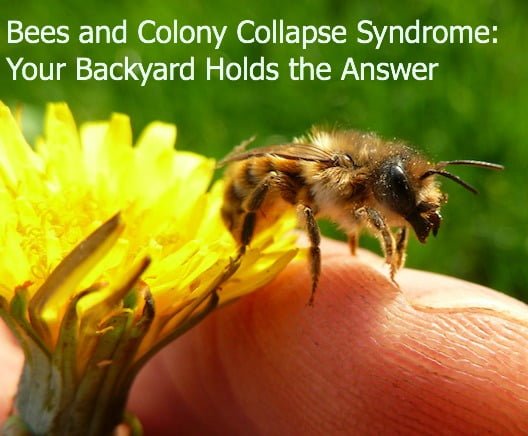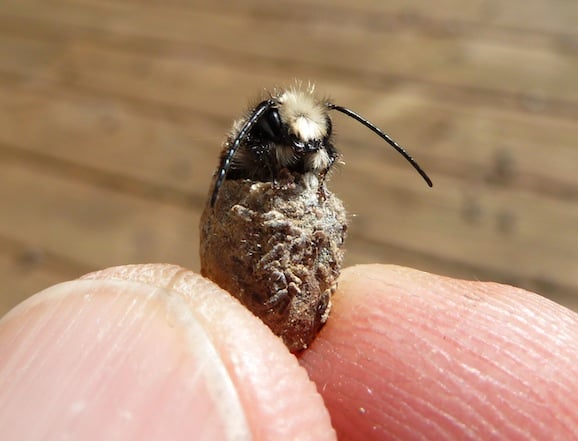Our honey bees continue to be challenged. Whether it’s climate change, GMO crops, cellular tower radiation, or a combination of factors, scientists have not been able to solve what’s killing these wonderful insects. More money is being shifted to “Plan B”, or finding what else can pollinate our crops and orchards.
Your backyard holds the answer. You can raise gentle bees that will be used in your regional farmlands PLUS provide a wonderful education to your children.
There are gentle bees that don’t want to sting
Most people think that there are only 5 bees in the world. Honey bees, bumble bees, all wasps, all hornets, and everything else. Would it surprise you to know there are over 8,000 species of bees, hornets, and wasps in North America alone?
There are two types of bees; social and solitary.
Social bees are bees that communicate and work with each other, like honey bees and bumble bees. They have a queen with worker bees that gather pollen/nectar, tend to the young, and defend their hives.
Solitary bees don’t communicate or work with each other, but they do want to live near to their neighbors. Each female bee is a queen, and she does it all! She gathers pollen and nectar, lays eggs, and gathers mud for her nest. She is extremely busy.
Solitary bees are gentle!
Since solitary bee queens have to do everything, it would be very hard to fly to flowers for pollen and nectar, gather mud, and also defend the hole in which she is placing everything. She can’t do it all! As a result, she doesn’t defend her hole/nest. She has no need to sting, and so doesn’t! It is very hard to get stung by a solitary bee.
The only way to get stung would be to squeeze one of them in your hand or get one caught in clothing where it might be scared. Because these solitary bees rarely sting, their venom is extremely mild, causing only a slight itch, much less than the itch associated with a mosquito bite.
Solitary bees are only active for a short time.
Each working bee, whether social or solitary lives about six weeks. In a honey bee hive, a queen lays a thousand eggs each day, and a thousand bees die each day. Their wings can only flap so long until they wear out. Because a honey bee queen is laying eggs every day, her hive has bees flying in and out from spring through the fall.
Since solitary bees only live six weeks, we find different bees emerging at different times of the year. All species of solitary bees come out of their cocoons at about the same time for them to pollinate their flowers that they like best. Spring mason bees will all come out when the plum and cherry trees are in bloom. Other types of solitary bees will come out when raspberries are in bloom, and still others emerge when gardens are in bloom.
Solitary bees are special pollinators
What makes bees so special is that they have incredibly powerful flower pollinating powers. It is remarkable what they set in motion. A pollinated flower in an apple tree creates an apple. A pollinated dandelion creates beautiful little umbrella seeds. How do they do it? Honey and bumble bees gather the pollen from the flowers and move it to their back legs. Hardly any pollen is leftover for the flower. Mason bees are very messy with how they pollinate. They belly flop on each flower, getting pollen everywhere on their furry bodies. The pollen stays on their undersides and falls off on the next flower. One mason bee can pollinate about 2,000 flowers, while a honeybee will only pollinate about 15 flowers even though they visit the same number of flowers.
Only the honeybee makes a lot of honey. No other bees produce honey except for the bumble bee that saves just a little bit to survive the winter. Solitary bees are wonderful pollinators and will give you lots of fruit and vegetables, just no honey.
You can raise these gentle and educational bees
Many types of solitary bees live in holes. The spring mason bees are very popular as they are in high demand for fruit trees. All you need for success is a mason bee house, some holes of the right size, nearby pollen, and a good source of clay/mud.
Having these gentle bees in your yard is easy and fun.
If you decide to raise mason bees, place the cocoon behind the nesting material. When it’s warm enough, the bees will cut their way out of their cocoon and will begin to fly around your yard looking for holes, pollen, and mud to use. Put their mason bee house on the warm side of your home at about head height so that you can watch what they’re doing. Put a few sticks in between some of the holes so that it looks messy.
The bees will emerge, mate, and begin nesting quickly. After about six to eight weeks, the bees will begin to expire. They’ve left eggs for next year in their holes, which will slowly grow, spin cocoons, and wait in hibernation for the following year.
There are a couple of extra steps to care for your bees, but they are all very easy to do. We know that it is easy to forget what to do through the year. Crown Bees has a reminder program called “Bee-Mail” that helps your know when to do what. There are also small articles of science and news on solitary bees that is educational.
Helping your farmers in years to come
From the scientists that we team with, a fear is that shortly, an orchard that needs 100 hives may only have 70. Either the farmer will produce less food, or he/she will have to find some other means of pollination.
Mason bees are easy, educational, safe, low cost, and they will increase in numbers substantially. At first, you’ll want to give your excess cocoons to friends, family, and neighbors. Later, we’ll help coordinate local “exchange” sites, potentially at your neighborhood nursery. Here, you’d exchange your excess cocoons for gift certificates or something meaningful.
Your cocoons, combined with your community’s cocoons, would then head towards your regional orchards/crops. Surprisingly, when you mix honey bees and mason bees together, the farmer winds up with significantly more produce.
Thanks to Dave Hunter of Crown Bees for this educational and fun article. For more information on how you can raise these bees, visit their website.
The post Bees and Colony Collapse Syndrome: Your Backyard Holds the Answer appeared first on Green Child Magazine.


